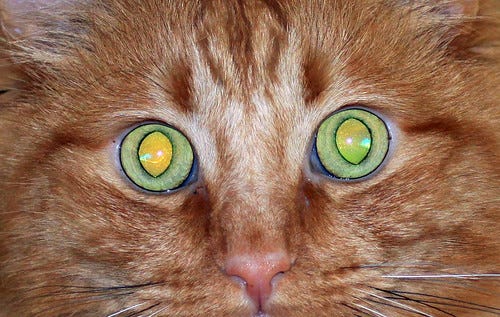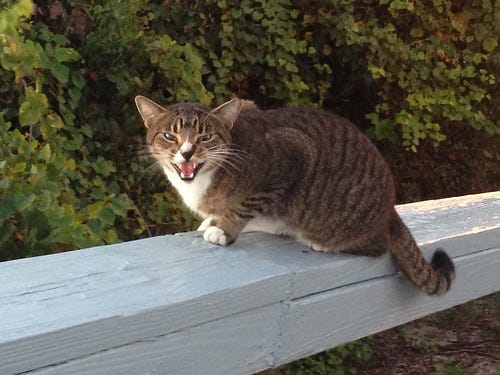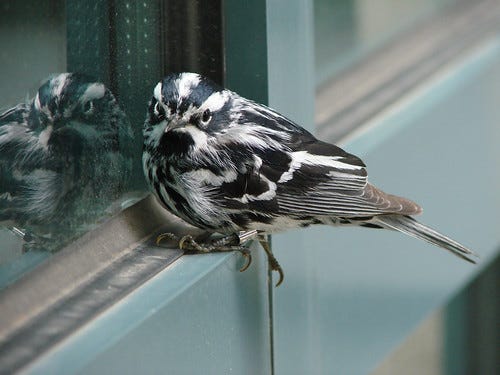Tunnel Vision
Conservation biologists focusing on their specialties need to see the big picture and collaborate, not undercut one another.
(Listen to the two-part radio version here: Part 1 and Part 2.)
When my 2006 book, 101 Ways to Help Birds, was published, a few conservation biologists dismissed it out of hand and some even disparaged it. The book focuses on a great many reasons why so many birds are declining, including cat predation; collisions with windows, transmission lines, and communications towers; pesticides; habitat degradation and loss on breeding grounds, migration stops, and wintering areas; fossil fuel extraction and consumption; driving too fast (wasting fuel as well as increasing wildlife collisions); and much more. Some scientists said I should have focused on the one root cause of bird declines, loss of habitat. The book includes a lot of information about how much habitat we’ve damaged or lost from development, agricultural practices, beef production, and more, but these researchers, whose own work was so centrally focused on how enormously habitat loss had figured in bird declines, lost sight of the many other issues contributing to bird declines.
“Generational amnesia” is a huge problem in bird conservation because wildlife biologists, like everybody else, can’t help but use their personal awareness of wildlife abundance at the start of their careers as their benchmark for “normal,” which becomes the standard target they’ll use throughout their career for managing numbers. Over decades, as populations shrink, so do management goals that should be working toward more robust populations.
Restoring bird populations to healthy, sustainable levels is also hampered by the tendency of scientists and research institutions to keep a laser focus on their own work and their own methods, losing sight of a lot of important information. When someone conducts a study that challenges or outright contradicts something that has long been believed to be true, the scientific approach is, first, to carefully test the new findings to see if they can be replicated. If new information proves valid, scientists from both ends should work out ways to integrate the new findings with the already established body of information to make solid advances and reset priorities when necessary.
Tragically, the first response for mainstream scientists is often to dismiss someone else’s new discoveries or methodologies out of hand, and scientists making a new discovery often disparage what they think is old-fashioned or even obsolete. Either way, bird conservation suffers, delaying acceptance of extremely important new work for years or decades while the criticisms by scientists with the new information give fuel to opponents of conservation legislation and regulations, whose goal is to make the public question the validity of important conservation policies. All the while, bird numbers continue to dwindle.
If new information proves valid, scientists from both ends should work out ways to integrate the new findings with the already established body of information to make solid advances and reset priorities when necessary.
Restoring populations for any vulnerable species is extremely complicated, often requiring several different approaches at the same time. Knowing habitat requirements throughout the year is essential, but so is a thorough understanding of all the various causes of mortality and the relative magnitude of each for that species.
Restoring bird populations is in many ways like human medicine. When I had breast cancer, I consulted with an oncologist, radiologist, surgeon, genetics specialist, and my family doctor to develop a course of treatment. I’d had a heart attack two years before, so hormone treatments for me would be riskier than average, and DNA tests revealed a mutation that made radiation riskier. Balancing the relative risks and benefits was complicated but essential for a healthy outcome. In the same way, individual bird populations often have complicating factors that make multiple approaches and cooperation among various experts essential.
Avian biologists who specialize in habitat management tend to approach conservation via biomes or specific habitats, making the obvious and valid assumption that protection of each kind of habitat will help all the species in it. When dealing with an endangered grassland bird, they of course prioritize grassland restoration, which they measure by plant community composition. But other issues are also critical for grassland birds.
In one study of radio-tagged Lesser Prairie-Chickens, over 25 percent of adult bird mortality was due to collisions with fences, the primary cause of death for adult females. (Collisions kill males, too, but their conspicuousness and lekking behaviors make predation an even bigger factor.) From the moment they can fly, grassland birds learn how yielding grasses and forbs are, winging through them effortlessly. The first time they try that with a rigid wire fence will be their last. In my 101 Ways to Help Birds, #26 is “Remove unnecessary fencing.” Lesser Prairie-Chickens are declining for a great many intractable reasons, but one way of helping local populations where fences are needed for grazing cattle is to mark the fences to make them more recognizable for the birds.

Healthy pastureland attracts grassland sparrows, Eastern and Western Meadowlarks, Bobolinks, Upland Sandpipers, Northern Harriers, Short-eared Owls, and more. When landowners mow in late spring and early summer, they destroy every egg and chick on that field. When driving through northern Wisconsin in June and early July, I know which pastures have just been mowed because gulls and crows comb through them, devouring so many tiny, mangled bodies. In 101 Ways to Help Birds, #27 is, “Cut hay and alfalfa as late in the breeding season as possible.” A couple of the conservation biologists I asked to review the manuscript suggested taking that one out, saying it was hard enough to motivate landowners to preserve healthy grasslands at all—if they felt under siege for their mowing practices, they might start growing timber or develop the land instead. Producing quality habitat to attract birds whose young would be doomed by early mowing didn’t make sense to me.
For decades, the critical importance of habitat protection and restoration was the paramount concern of conservation biologists. And the more solid and widely accepted their body of work became, the harder it became for them to step back and consider additional or alternative approaches to species protection.
For example, in 2006, many researchers and institutions were still insisting that such bird killers as domestic cats and windows harm individual birds but not populations. When I was working in the 1980s and ‘90s to get my city to adopt a cat-leash ordinance, National Audubon refused to provide a simple statement of support, insisting cats don’t pose problems for bird populations.
Meanwhile, some reviewers for major ornithological journals such as The Auk had long been blocking publication of Daniel Klem’s papers about window collisions because, in their professional judgment, windows were localized problems, killing small numbers of individual birds, not whole populations, and thus did not qualify as a serious conservation issue.
While I was writing my book, Klem presented at a major symposium his finding that somewhere between 100 million and a billion birds are killed at windows in the U.S. every year, and the national news media, and I, reported his numbers. But prominent biologists claimed that Klem was orders of magnitude off, and in their desire to put to rest what they judged to be an insignificant issue, set out to disprove Klem’s numbers. Ironically, their own studies confirmed the worst of Klem’s estimate, though somehow this led to their sudden claim that they themselves had discovered that windows kill on the order of a billion birds every year. Had they looked into the issue when Klem started publishing his work in the 1970s, perhaps we could have avoided using so much glass in construction in recent decades, reducing our use of fossil fuels for heating and cooling as well as saving birds directly.
Klem’s decades of solid work had been dismissed for decades, but now, in 2023, his associates at the Ornithology Center at Muhlenberg College seem to be doing the same thing in reverse. For months, I’ve been getting emails from them dismissing the work of a great many conservation biologists and organizations. One email, titled “The Fallacy of ‘10 Good Things for Birds’” makes the ridiculous claim that, “Even if the list of ‘good things for birds’ includes ‘prevent window collisions,’ it delivers the false message that the other ‘9 good things’ are equally effective.” Another email is titled “Experts Warn [that] Native Plants may Create ‘Ecological Traps,’” stating that no one should plant native plants in their yards or cities until every window is made bird-safe.
Yes, preventing window collisions is critical, but in the same way that my oncologist and cardiologist weren’t in competition, conservation biologists specializing on one problem have no business dismissing the problems other specialists are working on.
When I wrote in my book about the importance of siting wind turbines away from migration routes, people justifiably concerned about climate change said killing birds was a necessary cost for protecting the entire planet. This reminded me of an entirely different issue and the wonderful way it was resolved. In the early 1950s, Chandler Robbins learned that the Naval Air Station Midway, on Midway Island in the Pacific, which had been decommissioned in 1950, was re-commissioned in the face of the Korean War. Planning for the first jet aircraft take-offs and landings ever on the island, the military thought it best to banish or exterminate the island’s nesting albatrosses to avoid collisions. Robbins and some of his colleagues thought if scientists could figure out what vegetation the albatrosses preferred, what substrates they avoided, and their patterns for takeoffs and landings, they could perhaps design the runway areas so the birds would avoid them. Imagine that! Different government agencies cooperated to find the wisest long-term solutions for everyone concerned.
Wisdom the Laysan Albatross, banded by Robbins in 1956 as part of the research that solved the Midway Island situation, is living testament to the fact that collaboration and cooperation make the world a better place for humans and birds alike.











Jim Cubie of the Center of Ornithology at Muhlenberg College asked me to post this comment for him:
In a recent post Ms. Erickson stated that I had made a “ridiculous statement” that “every window must have crash prevention before the first native plant is installed.” I have never made such a statement.
Second, she stated that I had “denigrated” others working for birds by my statement that “ (A)ll the other “good things for birds” cannot make up for 1.25 billion bird deaths caused by cats and home windows.” (2-6 per home annually.)” https://ornithologycenter.com/cancer-window-collsions-and-cats/ Every major peer reviewed study has found that “cats and windows” are the chief causes or bird deaths – by far.
Saving a bird’s life – whether from cats or window collisions -- is qualitatively different than the other good things we do for birds. All the “good things we can do for birds” cannot help a dead bird.
My point is “start with a safe yard.” It is the same point that she made in her excellent post entitled” “What to Do Before Improving Your Backyard Habitat - Windows.” ( I included both windows and cats.)
Both Ms. Erickson and I were right.
Fantastic work, Laura. I really like how you do not back down when the so called experts (seems like a lot of men) challenge your thinking. Cheers!